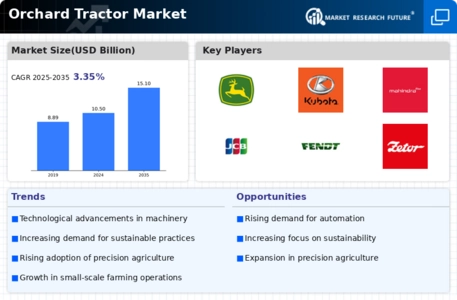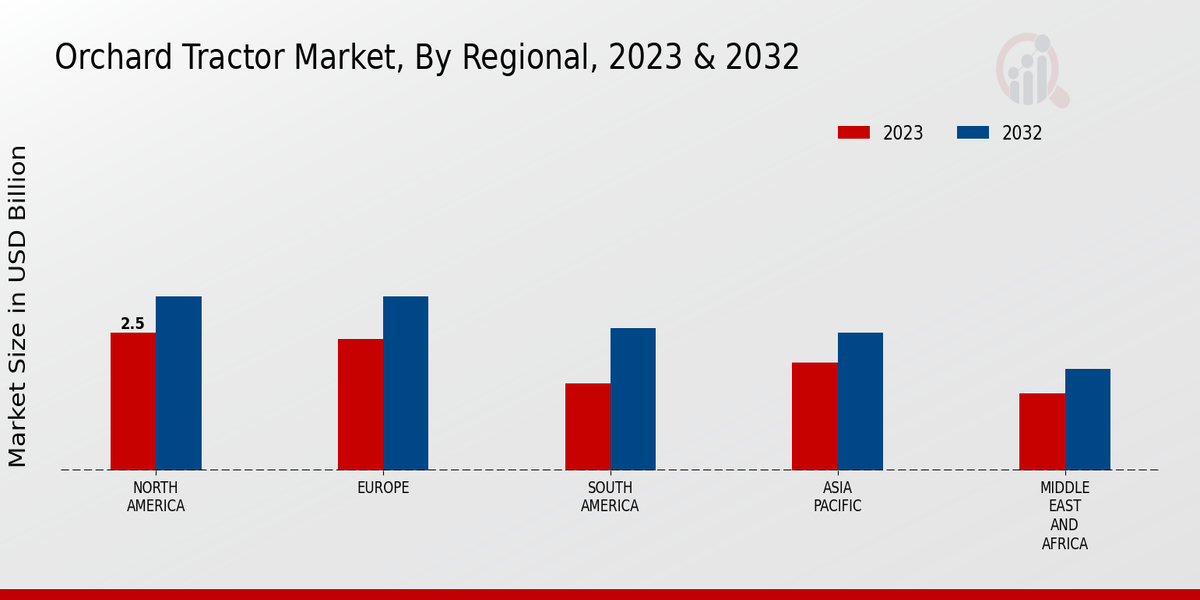Market Growth Projections
The Global Orchard Tractor Market Industry is projected to experience substantial growth over the coming years. With a market value of 10.5 USD Billion in 2024, the industry is anticipated to reach 15.1 USD Billion by 2035. This growth trajectory suggests a compound annual growth rate (CAGR) of 3.35% from 2025 to 2035. Such projections indicate a robust demand for orchard tractors, driven by factors such as technological advancements, government support, and the increasing focus on sustainable agricultural practices. The market's evolution reflects the dynamic nature of the agricultural sector and its adaptation to changing consumer preferences.
Government Initiatives and Subsidies
Government initiatives and subsidies significantly influence the Global Orchard Tractor Market Industry, as many countries implement programs to support agricultural modernization. These initiatives often include financial incentives for farmers to adopt advanced machinery, including orchard tractors. Such support not only enhances productivity but also encourages sustainable farming practices. For instance, various governments are promoting the use of eco-friendly tractors through subsidies, which may lead to increased market penetration. As a result, the market is poised for steady growth, with a projected CAGR of 3.35% from 2025 to 2035, reflecting the positive impact of these policies.
Expansion of Orchard Cultivation Areas
The expansion of orchard cultivation areas significantly impacts the Global Orchard Tractor Market Industry. As more regions around the world recognize the economic potential of fruit and nut production, the demand for specialized orchard tractors increases. This trend is particularly evident in developing countries where agricultural practices are evolving. The need for efficient machinery to manage larger orchards drives investments in advanced tractors, which are designed to navigate diverse terrains and optimize harvests. This expansion is expected to contribute to the overall market growth, as farmers seek reliable equipment to support their operations in newly established orchards.
Growing Focus on Sustainable Agriculture
The Global Orchard Tractor Market Industry is increasingly influenced by the growing focus on sustainable agriculture. As consumers demand more environmentally friendly practices, farmers are compelled to adopt tractors that align with sustainability goals. This shift is evident in the rising popularity of electric and low-emission tractors, which help reduce the carbon footprint of agricultural operations. The market's evolution towards sustainability not only meets consumer expectations but also complies with regulatory standards aimed at reducing environmental impact. Consequently, this trend is likely to drive market growth, as farmers invest in sustainable orchard tractors to enhance their operational efficiency.
Technological Advancements in Tractor Design
Technological advancements play a pivotal role in shaping the Global Orchard Tractor Market Industry. Innovations in tractor design, including the development of electric and hybrid models, contribute to sustainability and reduced environmental impact. These advancements appeal to eco-conscious farmers and align with global efforts to promote sustainable agriculture. The market is expected to grow to 15.1 USD Billion by 2035, reflecting the increasing acceptance of these technologies. Enhanced features such as improved fuel efficiency and lower emissions further bolster the attractiveness of modern orchard tractors, ensuring their relevance in the evolving agricultural landscape.
Rising Demand for Efficient Farming Equipment
The Global Orchard Tractor Market Industry experiences a notable increase in demand for efficient farming equipment, driven by the need for enhanced productivity in agricultural practices. As farmers seek to optimize their operations, the adoption of advanced orchard tractors equipped with precision technology becomes essential. This trend is reflected in the projected market value of 10.5 USD Billion in 2024, indicating a robust growth trajectory. The integration of features such as GPS guidance and automated systems not only improves efficiency but also reduces labor costs, making these tractors indispensable for modern orchards.














